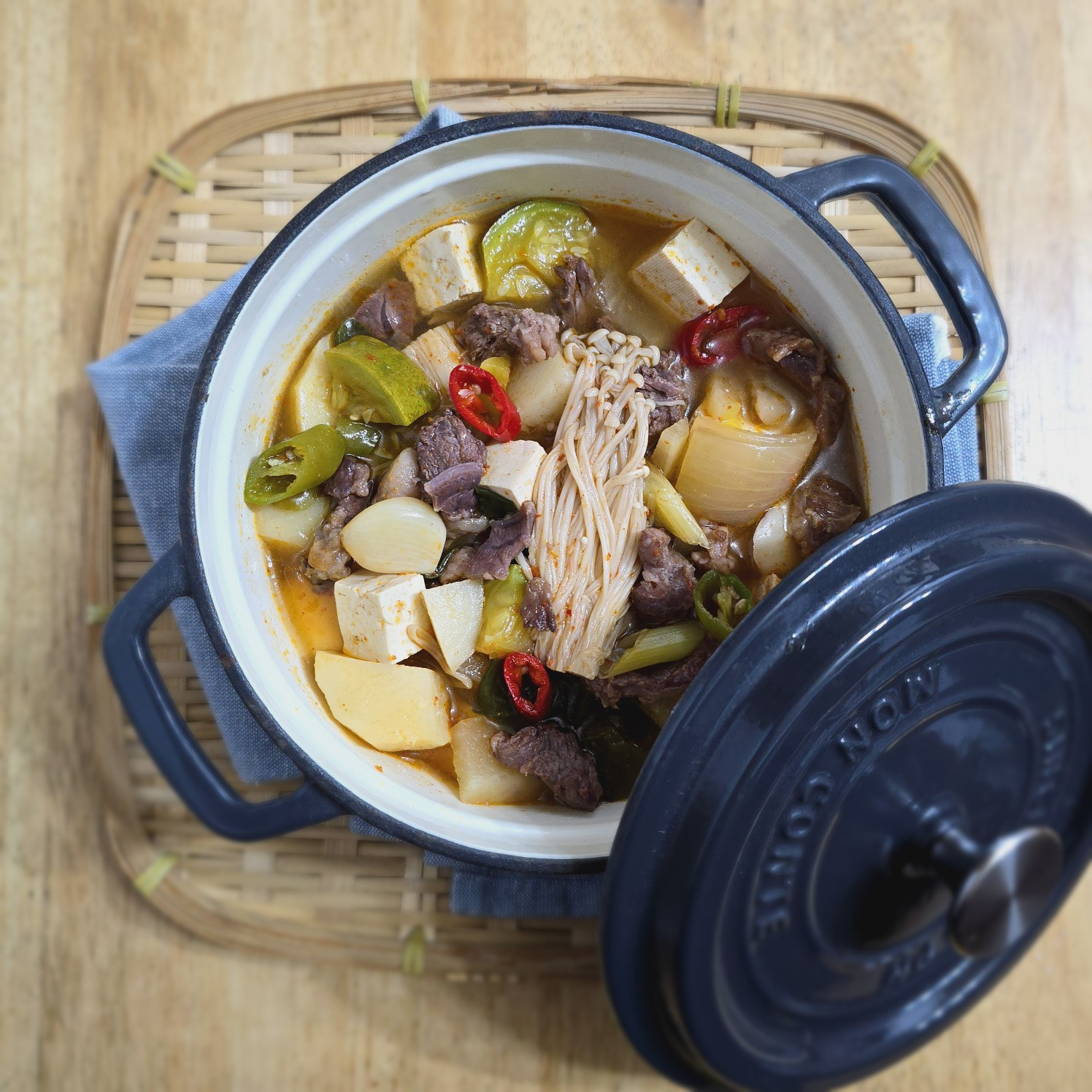Hearty Korean Beef and Soybean Paste Stew (So-gogi Doenjang Jjigae)
How to Make Delicious Korean Beef and Soybean Paste Stew

Hello everyone! I’m Ryu-i, your Naver food influencer. Today, I’m excited to share a recipe for a deeply flavorful Korean Beef and Soybean Paste Stew (Doenjang Jjigae), made with premium Korean beef that I received as a service from my regular butcher. The addition of beef makes this stew incredibly rich and savory, so much so that my younger son, who usually isn’t a big fan of doenjang jjigae, happily ate it mixed with rice. I highly recommend this comforting and delicious stew for your next family meal!
Main Ingredients- Beef for stew, 150g (cut into bite-sized pieces)
- Tofu, 1 block
- Korean radish (Mu), 1 piece (approx. 2cm thick)
- Onion, 1 medium
- Potatoes, 2 medium
- Zucchini, 1/2 medium
- Green onion, 1/2 stalk
- Korean chili peppers (Cheongyang), 1-3 (adjust to spice preference)
- Red chili pepper, 1/2 (for color)
- Anchovy broth, 1L (or 1L water + kelp/anchovy sachet)
Seasoning- Doenjang (Korean soybean paste), 3 Tbsp
- Gochugaru (Korean chili flakes), 2 Tbsp
- Minced garlic, 1 Tbsp
- Fish sauce (anchovy, sand lance, or tuna), to taste
- Doenjang (Korean soybean paste), 3 Tbsp
- Gochugaru (Korean chili flakes), 2 Tbsp
- Minced garlic, 1 Tbsp
- Fish sauce (anchovy, sand lance, or tuna), to taste
Cooking Instructions
Step 1
First, prepare the anchovy broth, which is key to the stew’s deep flavor. Boil 1L of water with an anchovy broth sachet or a piece of dried kelp to create a rich broth. Set aside. (Skip if using store-bought broth).

Step 2
Prepare the vegetables. Dice the onion, potatoes, and zucchini into approximately 1.5-2cm cubes. Thinly slice the green onion and chili peppers diagonally. Trim the base of the enoki mushrooms, rinse them under cold running water, and separate the strands.

Step 3
Dice the tofu into roughly 1.5-2cm cubes. Cutting them too small can cause them to break apart during cooking, so aim for a similar size to the other diced vegetables.

Step 4
Pat the beef dry thoroughly with paper towels to remove any excess blood. Removing the blood helps ensure a clean and odorless stew.

Step 5
Lightly grease a pot with sesame oil over medium heat. Add the drained beef and stir-fry until it’s lightly browned on the outside. Don’t overcook it at this stage.

Step 6
Add the thickly sliced Korean radish to the pot and sauté with the beef until coated in oil. This step helps the radish become tender and enhances the broth’s flavor.

Step 7
Pour in the prepared 1L of anchovy broth. Place the 3 Tbsp of doenjang in a fine-mesh sieve over the pot and gently stir it into the broth until fully dissolved. Make sure there are no lumps.

Step 8
Bring the stew to a simmer over medium heat and cook for about 5 minutes. Skim off any foam that rises to the surface to keep the broth clear and clean. This allows the flavors of the beef and radish to meld into the broth.

Step 9
If you have a little extra time, turn off the heat and let the stew rest for about 5 minutes. This resting period allows the radish to become even more translucent and further deepens the umami flavors.

Step 10
Add the diced zucchini, potatoes, onion, and tofu to the pot. It’s best to add them considering their cooking times.

Step 11
Stir in the 2 Tbsp of gochugaru for a bit of spice and 1 Tbsp of minced garlic to enrich the flavor. Mix well to combine all the seasonings.

Step 12
Once the potatoes are about halfway cooked (after about 5-7 minutes), add the enoki mushrooms, sliced green onions, and chili peppers to the stew. Continue to simmer. Adding these ingredients later prevents them from becoming overcooked and mushy.

Step 13
Simmer for a short while until the green onions are just wilted. Taste the stew and adjust the seasoning with fish sauce (anchovy, sand lance, or tuna sauce) if needed. Fish sauce adds an extra layer of savory depth. Enjoy your delicious stew!



